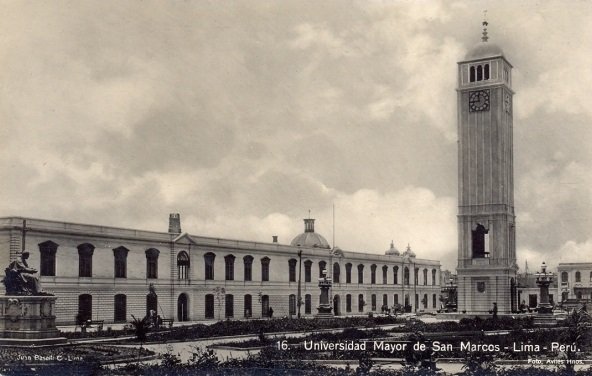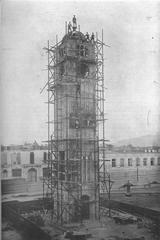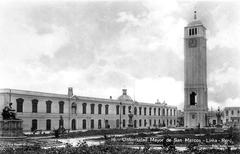
Torre Alemana, Lima, Peru: Visiting Hours, Tickets & Comprehensive Travel Guide
Date: 14/06/2025
Introduction
Torre Alemana—also known as the German Tower or Torre Reloj del Parque Universitario—stands as an enduring symbol of Lima’s multicultural heritage and the historic ties between Peru and Germany. Erected in 1921 as a centenary gift from the German immigrant community to celebrate Peru’s independence from Spain, this 29-meter neoclassical clock tower is a landmark of architectural beauty and historical significance. Located in Parque Universitario, opposite the Universidad Nacional Mayor de San Marcos—the oldest university in the Americas—the tower is a central point of civic pride and social gathering.
This guide provides an in-depth look at Torre Alemana’s history, cultural relevance, architectural features, visiting information, accessibility, nearby attractions, and practical tips for travelers.
Historical Background and Significance
Origins and Construction
Torre Alemana was constructed in 1921 by the German immigrant community as a centennial gift for Peru’s independence. Built in the neoclassical style with Germanic influences, the tower’s four-part design features a rusticated ochre base, commemorative bronze plaques, decorative oculi, and a copper dome. These elements reflect a blend of European architectural traditions and Peruvian cultural motifs (El Comercio; Expresión Diario).
Symbolism and Cultural Role
Beyond its visual appeal, Torre Alemana is a powerful emblem of international friendship and cultural exchange. The clock tower has long been a focal point for public gatherings, cultural ceremonies, and celebrations—most notably around Peru’s Independence Day. Its historic clock is famous for chiming the Peruvian national anthem at set times, serving as a daily reminder of national unity (Expresión Diario).
Integration Within Lima’s Historic Center
As part of Lima’s UNESCO-listed Historic Centre, Torre Alemana contributes to the area’s status as a World Cultural Heritage Site. The tower complements nearby colonial mansions, churches, and monuments, reinforcing its importance within Lima’s rich urban tapestry (Free Walking Tours Peru).
Restoration and Preservation
Recent restoration efforts led by Prolima have focused on cleaning, metalwork, dome repair, and the installation of new ornamental lighting. These initiatives aim to preserve the tower’s historical integrity and enhance its presence within the cityscape, especially after dusk. The latest restoration is expected to conclude in August 2025 (El Comercio).
The German Community’s Legacy
The tower stands as a tribute to the German community’s influence on Lima, representing broader immigrant contributions to the city’s commerce, arts, and education (Expresión Diario).
Visitor Information
Visiting Hours
- Open: Tuesday to Sunday, 9:00 AM to 6:00 PM
- Closed: Mondays and public holidays
Tickets and Admission
- Admission: Free entry for all visitors
- Guided Tours: Available on weekends or by appointment. Check with the local tourism office or visitor center for schedules.
Accessibility
- Wheelchair Access: The tower and Parque Universitario offer paved paths and ramps, ensuring accessibility for visitors with mobility needs.
How to Get There
- Location: Parque Universitario, Historic Center of Lima
- Public Transport: Well-connected by bus and metro; taxi and rideshare options are also available.
- Nearby Landmarks: Within walking distance of Plaza de Armas, Cathedral of Lima, and the Universidad Nacional Mayor de San Marcos.
Nearby Attractions
- Plaza de Armas: Lima’s main square surrounded by colonial architecture
- Cathedral of Lima: A historic church with impressive interiors
- Casona de San Marcos: A former colonial mansion, now part of the university
- Additional Sites: Museums, historical mansions, and vibrant local markets
Special Events
Torre Alemana regularly features in cultural events, civic ceremonies, and festivals, especially during national holidays and heritage celebrations.
Architectural Features
Structural Design
- Materials: Reinforced concrete with ochre and white neoclassical finishes
- Base: Rusticated ochre, with commemorative plaques and reliefs symbolizing Peruvian and German ties
- First Body: North and south entrances, decorated with Germanic and classical motifs, including depictions of a German soldier and the passage of time
- Upper Levels: Clock faces on all four sides, arched openings, balustraded galleries, and a copper dome crowned with wooden finials
- Decorative Details: Rich in symbolism, with plaques, reliefs, and classical elements reflecting themes of time, memory, and international friendship
The Clock Mechanism
- Installation: German-made mechanical clock installed in 1923
- Operation: Manual winding, traditional gear and pendulum system
- Chiming Tradition: Plays the first stanza of the Peruvian National Anthem at 8:00 AM, 12:00 PM, 6:00 PM, and midnight
- Maintenance: Subject to periodic restoration, with major work completed in 1937, 2001, and ongoing in 2025
Visitor Experience
- Guided Tours: Offer access to the tower’s interior, clock mechanism, and historical insights (when available)
- Photography: The tower’s striking architecture and garden surroundings make it a popular spot for photos—especially during sunrise and sunset
- Night Illumination: New LED lighting highlights the tower’s features after dark, enhancing its nighttime appeal
Practical Tips for Visitors
- Safety: Parque Universitario is generally safe during the day; exercise caution at night and secure your belongings
- Amenities: Benches, shaded areas, and public restrooms are available in the park
- Food & Drink: Vendors offer Peruvian snacks (anticuchos, churros) nearby; restaurants are found in the historic center
Accessibility & Inclusion
- Paths: Paved and mostly flat, suitable for wheelchairs and strollers
- Facilities: Benches, rest areas, and accessible restrooms located throughout the park
Sustainable and Responsible Tourism
- Respect the Site: Climbing or defacing the monument is prohibited
- Litter: Use trash bins to maintain the park’s cleanliness
- Support Local Vendors: Purchasing from local sellers benefits the community
Frequently Asked Questions (FAQ)
Q: Is there an entrance fee?
A: No, the site is free for all visitors.
Q: Are guided tours available?
A: Yes, often on weekends or by appointment; contact local tourism offices for details.
Q: Is the site accessible for people with disabilities?
A: Yes, both the park and tower surroundings are accessible.
Q: Can you go inside the tower?
A: Interior visits are only possible during guided tours.
Q: When does the clock chime the national anthem?
A: At 8:00 AM, 12:00 PM, 6:00 PM, and midnight each day.
Q: What are nearby attractions?
A: Plaza de Armas, Cathedral of Lima, Casona de San Marcos, and local museums.
Visuals and Interactive Media
- Images: Photographs of Torre Alemana and its architectural details (with optimized alt tags for accessibility and SEO, e.g., “Torre Alemana clock tower Lima”)
- Interactive Map: Location within Parque Universitario and proximity to other attractions
Additional Resources
Conclusion
Torre Alemana is a jewel of Lima’s historic center—offering a window into the city’s layered past, multicultural identity, and architectural splendor. Its accessible location, free entry, and proximity to other key landmarks make it an essential stop for any visitor to Lima. Ongoing restoration ensures that future generations will continue to appreciate this monument’s historical and cultural resonance.
To enhance your visit, consider joining a guided tour, exploring nearby sites, and attending special events. Stay updated through official tourism resources and make the most of your Lima experience with tools like the Audiala mobile app.
Sources and Further Reading
- Torre reloj del Parque Universitario: el monumento centenario que volverá a tocar el himno nacional, El Comercio
- La comunidad alemana en Lima: un repaso a su historia y legado, Expresión Diario
- Historic Center of Lima, Peru, Free Walking Tours Peru
















































































































